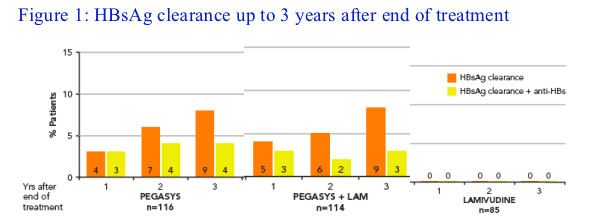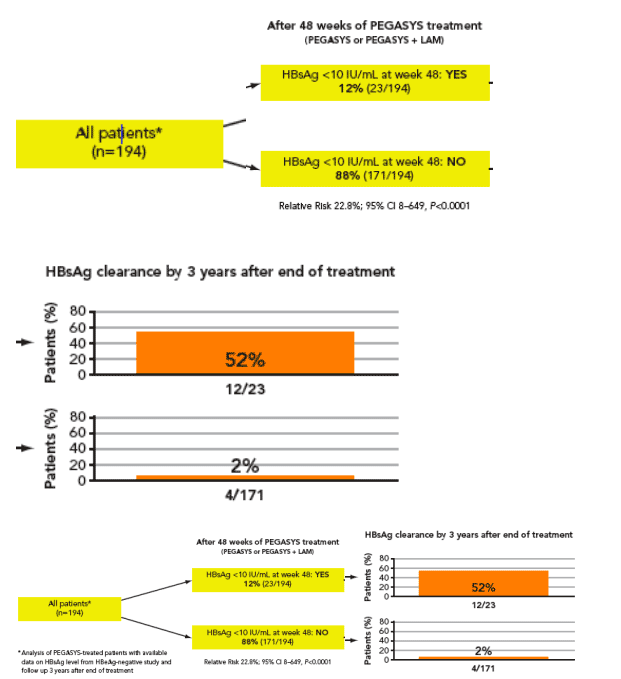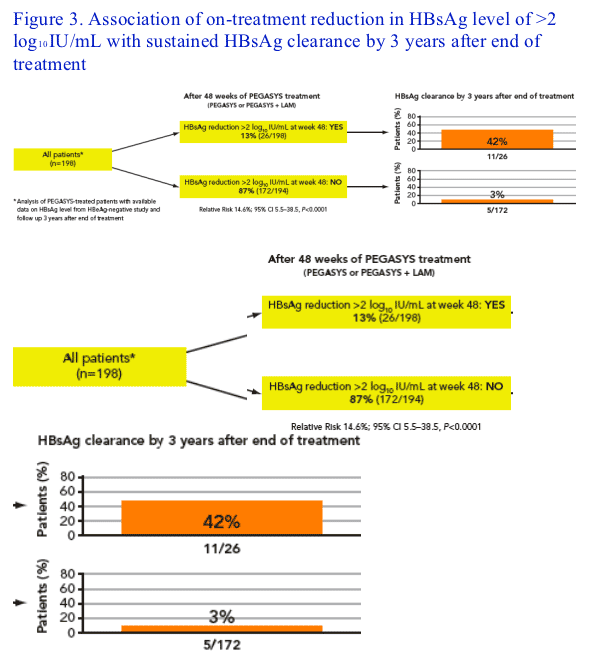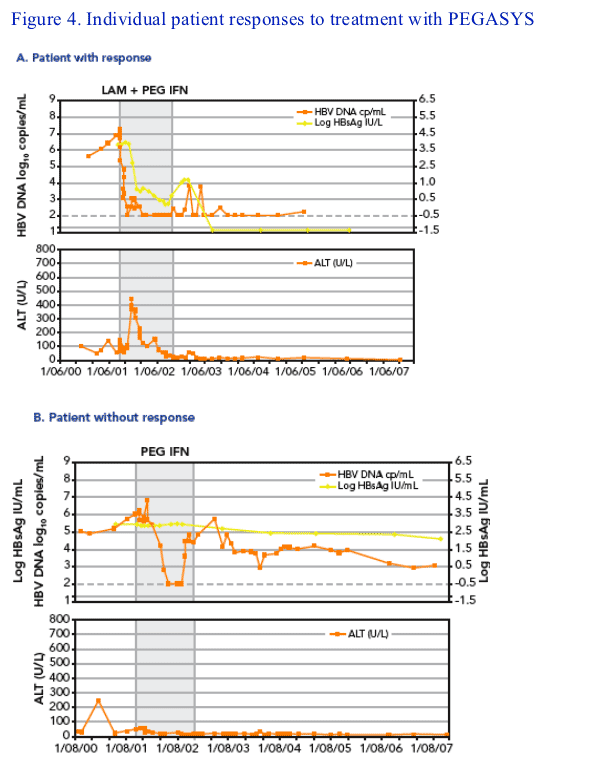 |
 |
 |
| |
On-treatment HBsAg decline in HBeAg-negative patients as a predictor of response to peginterferon alfa-2a (40KD) therapy 3 years off-treatment: potential for response-guided therapy
|
| |
| |
Reported by Jules Levin
43rd EASL April 2008, Milan
Maurizia Brunetto1, Ferruccio Bonino2, George K.K. Lau3, Patrizia Farci4, Cihan Yurdaydin5, Teerha Piratvisuth6, Stephanos Hadziyannis7, Zhi-Meng Lu8, Jian Wu9, Matei Popescu10, Patrick Marcellin11
1UO Gastreonterologia ed Epatologia, Azienda Ospedaliera Universitaria Pisana, Pisa, Italy; 2Scientific Direction, Foundation IRCCS Policlinico of Milan and University of Pisa, Italy; 3Department of Medicine, Queen Mary Hospital, Hong Kong, China;
4Dipartimento di Scienze Mediche, Universita di Cagliari, Monserrato, Italy; 5Department of Gastroenterology, University of Ankara, Turkey; 6Department of Internal Medicine, Songklanagarind Hospital, Prince of Songkla University, Hat Yai, Thailand;
7Department of Medicine and Hepatology, Henry Dunant Hospital, Athens, Greece; 8Department of Infectious Diseases, Ruijin Hospital, Shanghai, China; 9Roche, Dee Why, Australia; 10Roche, Basel, Switzerland; 11Service d'Hepatologie, Hopital Beaujon, University of Paris, Clichy, France
This research was partly funded by Roche, Basel, Switzerland
INTRODUCTION
· Hepatitis B e antigen (HBeAg)-negative chronic hepatitis B (CHB) has a poor prognosis, with only rare incidences of spontaneous remission1,2,3
· In a recent large, multicentre, randomised study of patients with HBeAg negative CHB, peginterferon alfa-2a demonstrated significantly higher off treatment virological, biochemical and serological response rates than lamivudine, both as a monotherapy and in combination with lamivudine4
· Clearance of HBsAg is the hallmark of successful immunological control of HBV infection and is associated with favourable clinical outcomes including a lower incidence of cirrhosis and hepatocellular carcinoma, and improved survival
· We investigated whether there was a possible association between on treatment HBsAg level reduction and response 3 years after end of treatment in patients treated with peginterferon alfa-2a ± lamivudine for 48 weeks and whether quantitative HBsAg may be useful for predicting subsequent HBsAg clearance 3 years after end of treatment
SUMMARY
· PEGASYS-based treatment induced HBsAg clearance in 8% of patients by 3 years after end of treatment
· HBV DNA ≦400 copies/mL at end of treatment was not associated with HBsAg clearance by 3 years after end of treatment
· Logistic regression analysis revealed a significant association between end of treatment HBsAg level and sustained HBsAg clearance by 3 years after end of treatment
- An end of treatment HBsAg level <10 IU/mL or an on-treatment reduction in HBsAg level from baseline at week 48 of >2 log10 IU/mL were significantly associated with sustained HBsAg clearance by 3 years after end of treatment with PEGASYS (with or without LAM)
- Patients with an end of treatment HBsAg level <10 IU/mL had more than 20 times the chance of sustained HBsAg clearance by 3 years after end of treatment compared with those with HBsAg levels >10 IU/mL at end of treatment
· Lack of reduction in HBsAg level at end of treatment was a negative predictor for subsequent HBsAg clearance or of HBV DNA suppression to <400 copies/mL by 3 years after end of treatment
CONCLUSION
· Given the ability of PEGASYS to induce and sustain HBsAg clearance, it can be considered as a first-line treatment approach for patients with HBeAg-negative disease who may otherwise need potentially life-long treatment with direct antivirals to maintain HBV DNA suppression
· Quantification of HBsAg levels may be useful for monitoring on treatment response to PEGASYS-based treatment and potentially provides a basis for a response-guided therapeutic approach
PERSPECTIVE
Could the monitoring of HBsAg levels during therapy help guide treatment?
· Suppression of HBV DNA is required to achieve a sustained off treatment response: its early monitoring (3-6 months) could be useful to indicate treatment efficacy, namely to distinguish primary responders from non-responders; non-responders may benefit from switching to an alternative treatment strategy
· Measuring the decline of HBsAg during treatment could be used to predict sustained response and may guide us to extend treatment duration in patients with a primary response, but slow decline in HBsAg (Figure 5)
· Further studies are required to test whether such an approach can be used to individualise treatment strategies
STUDY AIM
· To investigate a possible association between pre-treatment or on-treatment factors and HBsAg clearance 3 years after end of treatment in patients with HBeAg-negative CHB who were treated with peginterferon alfa-2a (PEGASYS) ± lamivudine (LAM) for 48 weeks
· To determine if quantitative HBsAg could be a potential predictor of long-term HBsAg clearance following PEGASYS-based therapy
METHODS
· In an initial study, 537 patients were randomised to receive 48 week's treatment with PEGASYS (n=177), PEGASYS + LAM (n=179) or LAM (n=181)
- All patients were positive for HBsAg and negative for anti-HBs pre-treatment
· A subset of 264 PEGASYS-treated patients had quantitative HBsAg data available pre-treatment, at end of treatment and at 6 months after end of treatment
· Of these, 198 participated in a long-term roll-over study in which patients were followed up to 3 years after end of treatment
- Patients who had an alanine aminotransferase (ALT) value >2 x ULN or HBV DNA levels >100,000 copies/mL at 48 weeks after end of treatment discontinued the study and were considered to be non-responders in the analyses
- Patients receiving either registered or investigational therapy for chronic hepatitis B during the follow-up period were excluded from the follow-up phase and were regarded as non-responders in the observational protocol
Quantification of HBsAg
· HBsAg was quantified using the Architect HBsAg assay (Abbott Laboratories; range 0.05-250.0 IU/mL) after 1:100 dilution:
- Samples with HBsAg levels higher than 250.0 IU/mL at 1:100 dilution were retested at a final dilution of 1:1,000
- Samples with HBsAg levels <0.05 IU/mL at 1:100 dilution were retested undiluted
Statistical analysis
· Logistic regression analysis was used to identify potential factors that could be associated with HBsAg clearance by 3 years after end of treatment
· Factors investigated included: age, baseline ALT, baseline HBV DNA, HBsAg level at week 48, and treatment with PEGASYS vs PEGASYS + LAM
· Classification and regression tree (CART) analyses were performed using CART software to investigate the negative and positive predictive values, as well as sensitivity and specificity of end of treatment HBsAg levels, for predicting response to PEGASYS at 3 years after end of treatment
- Both change in HBsAg level from baseline and absolute HBsAg level were assessed
- Response parameters used were HBsAg clearance and HBV DNA ≦400 copies/mL by 3 years after end of treatment
RESULTS
HBsAg clearance by 3 years after end of treatment
· 8% of PEGASYS-treated patients had cleared HBsAg vs no LAM-treated patients (P=0.009) (Figure 1)
· 44% (n=8) of patients who cleared HBsAg also developed anti-HBs by 3 years after end of treatment (Figure 1)

Lack of correlation between end of treatment HBV DNA suppression and HBsAg clearance by 3 years after end of treatment in PEGASYS-treated patients
· There was no significant correlation between end of treatment HBV DNA suppression and HBsAg clearance by 3 years after end of treatment (RR 3.07; 95% CI 0.42-22.47; P=ns) in patients treated with PEGASYS (PEGASYS or PEGASYS + LAM)
- 83% (161/194) of patients achieved HBV DNA suppression to ≦400 copies/mL at end of treatment. Of these, 9% cleared HBsAg by 3 years after end of treatment
- 17% (33/194) of patients didn't achieve HBV DNA suppression to ≦400 copies/mL at end of treatment. Of these, 3% cleared HBsAg by 3 years after end of treatment
Multivariate logistic regression for parameters associated with sustained HBsAg clearance by 3 years after end of treatment
· Multivariate logistic regression confirmed that end of treatment HBsAg level was a significant predictor of HBsAg clearance by 3 years after end of treatment (Table 1)
· There was no association between baseline parameters of age, ALT, HBV DNA or treatment with peginterferon alfa-2a vs peginterferon alfa 2a plus lamivudine, nor with HBV DNA level at end of treatment (Table 1)

Prediction of sustained HBsAg clearance by 3 years after end of treatment using quantification of HBsAg
· An end of treatment HBsAg level <10 IU/mL or an on-treatment reduction in HBsAg level of >2 log10 were significantly associated with sustained HBsAg clearance by 3 years after end of treatment (P<0.0001 for both parameters) (Figures 2 and 3)
- Patients with an end of treatment HBsAg level <10 IU/mL had more than 20 times the chance of sustained HBsAg clearance by 3 years after end of treatment compared with those with HBsAg levels >10 IU/mL at week 48
· In contrast, suppression of HBV DNA to ≦400 copies/mL at the end of treatment was not significantly associated with sustained HBsAg clearance by 3 years after end of treatment
Figure 2. Association of HBsAg level of <10 IU/mL at week 48 with sustained HBsAg clearance by 3 years after end of treat
I've put the graph here in two ways to make it fit and readable. In the first figure (2) 52% with HBsAg <10 Iu/ml at week 48 achieved HBsAg clearane by 3 years after end of treatment. And in the next Figure (3) 42% with on-treatment reduction of HBsAg by 2 logs cleared HBsAg by 3 years after end of treatment.


Determining the best cut-off levels to predict HBsAg clearance of HBV DNA suppression at 3 years after end treatment
· CART analysis provided cut-off values for differentiating between those patients who would be likely to have HBsAg clearance or HBV DNA suppression to <400 copies/mL by 3 years after end of treatment
· The best predictive values of sustained HBsAg clearance at 3 years after end of treatment were found to be HBsAg levels <380 IU/mL at end of treatment and on-treatment reduction in HBsAg of >1.87 log10
- 32% (64/198) of patients had HBsAg <380 IU/mL at end of treatment; of these 25% (16/64) had sustained HBsAg clearance by 3 years after end of treatment
- 14% (27/198) of patients had an on-treatment reduction of >1.87 log10 HBsAg; of these 44% (12/27) had sustained HBsAg clearance by 3 years after end of treatment
· The best predictive values of HBV DNA ≦400 copies/mL by 3 years after end of treatment were HBsAg levels <19 IU/mL at end of treatment and a >0.46 log10 reduction in HBsAg on treatment
- 14% (27/198) of patients had HBsAg <19 IU/mL at end of treatment and 41% (82/198) had >0.46 log10 reduction in HBsAg
· Positive and negative predictive values, and test sensitivity and specificity, are shown in Table 2

CART analysis revealed:
· The negative predictive value of HBsAg reduction >380 IU/mL at the end of treatment for subsequent HBsAg clearance by 3 years after end of treatment was 100%
· The negative predictive value of a reduction <1.87 log10 in HBsAg level from baseline to end of treatment for subsequent HBsAg clearance by 3 years after end of treatment was 98%
· Similar negative predictive values were observed for HBV DNA ≦400 copies/mL by 3 years after end of treatment
Patient profiles during and after PEGASYS-based therapy
· HBsAg, HBV DNA and ALT levels for: A) a patient with on-treatment HBsAg decline and B) a patient without an on-treatment HBsAg decline are shown in Figure 4
- Patient A meets the positive predictive criteria (Table 2) for response by 3 years after end of treatment
- Although Patient B had an initial reduction in HBV DNA, at end of treatment the reduction in HBV DNA was <1.87 log10. Moreover, HBsAg levels hardly changed during treatment

REFERENCES
1. Funk ML et al. World-wide epidemiology of HBeAg-negative chronic hepatitis B and associated precore and core promoter variants. J Viral Hepat 2002;9:52-61.
2. EASL International Consensus Conference on Hepatitis B: 13-14 September, 2002 Geneva, Switzerland: consensus statement long version. J Hepatol
2002;39:Suppl1:S3-S25.
3. Zarski JP et al. Characteristics of patients with chronic hepatitis B in France: predominant frequency of HBe antigen negative cases. J Hepatol 2006;45(3):355-60.
4. Marcellin P et al. Peginterferon alfa-2a alone, lamivudine alone, and the two in combination in patients with HBeAg-negative chronic hepatitis B. N Engl J Med 2004;351:1206-17.
|
| |
|
 |
 |
|
|